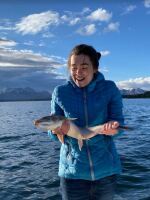The Alaska Board of Fisheries will decide next month whether and how to change Nushagak District fisheries management in an attempt to conserve the faltering king salmon runs. The deadline to submit on-time public comments is Feb. 23. The board members have said they will pay close attention to what the local advisory committee and stakeholders recommend.
But the Nushagak Advisory Committee, which is tasked with recommending regulatory changes, has yet to complete its suggestions on the state’s draft action plan to protect kings.
“We will bring ideas to the table at the meeting,” said Chair Susie Jenkins-Brito, speaking toward the end of the committee’s second meeting to discuss the king salmon action plan. “But we don’t have the luxury of time.”
The plan, drafted by the Alaska Department of Fish and Game, has 15 options to shift or restrict commercial, sport and subsistence fishing in the district, from keeping the current regulations to reducing fishing area and time to closing the fisheries altogether.
At its meeting last week, the committee unanimously opposed keeping the status quo management (Action 1), and it also opposed shutting down the commercial fishery (Action 6).
The committee supported changing the sockeye escapement goal (action 3), which would reduce commercial fishing to allow more to kings escape, but it didn’t decide on any specifics, and passed the action along to the king salmon subcommittee to figure out the details.
“The idea is telling the department that it’s OK to have more fish to go up the Wood or the [Nushagak], or both, in order to protect kings,” said Fish and Game Area Management Biologist Tim Sands. “You can't really protect king salmon unless you're foregoing harvest on sockeye salmon.”
There was also extensive discussions about Action 2, which would open the Wood River Special Harvest Area to the fleet early in the season while the rest of the district remains closed, and Action 4, which would reduce mesh size and/or net length, but no decisions were made.
“We just set the dates and then we know those dates for a tide, we're going to be in a smaller district with less gear in an effort to allow genetic diversity to go through and then at that same time, maybe the sport fishery is closed, however many hours later it is that those kings go up the Nushagak River,” she said. “I don't think not fishing at all on the front end is the solution, because the big kings are going to be at the end of the season, and we need genetic diversity to be successful.”
The members also considered Action 5 to reduce fishing time and area. While one member thought this would disenfranchise drift fishermen, the committee voted to continue that discussion. Secretary Dan Dunaway said he thinks this action could be effective at reducing king harvest, adding that fishing restrictions could extend longer than others had suggested.
“I like the idea, cause I think to really be effective we're going to need to reduce some area," he said. "I would almost say it might need to run longer — July 1 — just from my experience in watching how the kings come in. But I tend to support it, and the idea of less gear for that period."
Area Management Biologist Sands said no matter what the committee decides, defining certain triggers for Fish and Game to open commercial fishing in the district would be extremely helpful for management. Those triggers could be sockeye escapement goals or a date to start fishing.
“The big question is, ‘How many sockeye salmon should we forego harvest opportunity on in order to protect Nushagak kings?’” he said. “The only way we get that answer is to get some kind of trigger.”
The committee also voted against continuing the status quo management for the sport fishing. It lost its quorum before it could address the rest of the sport or subsistence proposals.
Meanwhile, Sands said he’d heard concerns from stakeholders who worried about how long the action plan will remain in effect. Sands expects Nushagak kings to remain a stock of concern through the next two board cycles, which would be in six years.
“Our solution was to make it a separate plan and have in the intent language that starts off the plan, to say ‘This is only pertinent as long as Nushagak king salmon are a stock of concern,’”
The statewide Board of Fish meeting starts on March 10 in Anchorage.
The king salmon subcommittee will meet to further discuss the options at 10 a.m. on Friday, Feb. 17, in the ADF&G office in Dillingham. It is tasked with discussing the optimum escapement goal for sockeye, the use of the Wood River Special Harvest Area, gear restrictions and whether to reduce time and area of fishing to allow more kings a chance to escape.
Get in touch with the author at izzy@kdlg.org or 907-842-1002.






